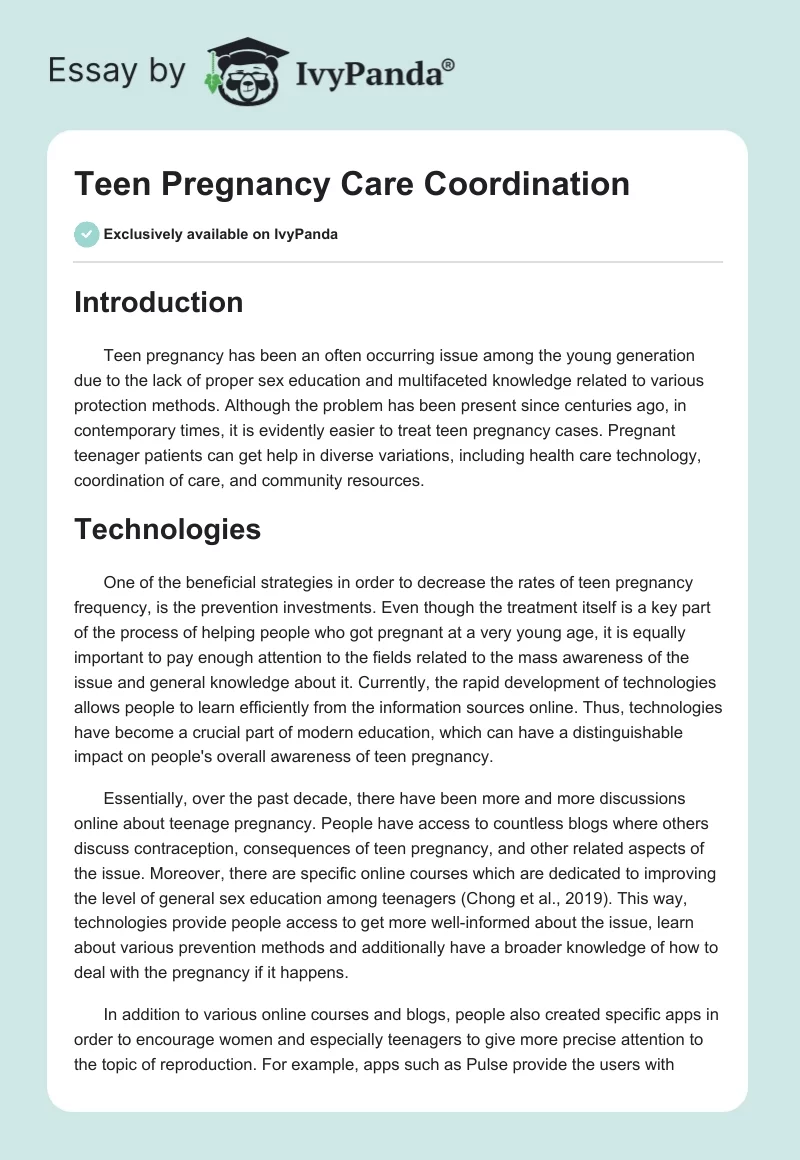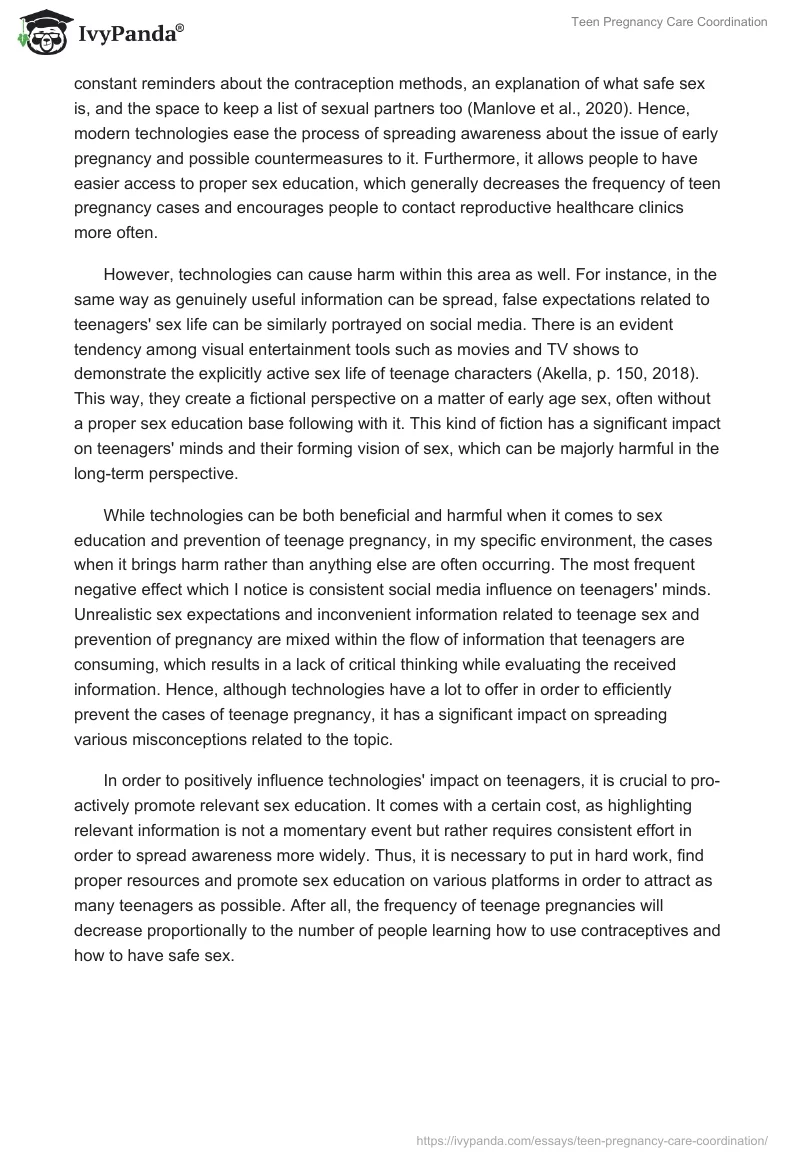Introduction
Teen pregnancy has been an often occurring issue among the young generation due to the lack of proper sex education and multifaceted knowledge related to various protection methods. Although the problem has been present since centuries ago, in contemporary times, it is evidently easier to treat teen pregnancy cases. Pregnant teenager patients can get help in diverse variations, including health care technology, coordination of care, and community resources.
Technologies
One of the beneficial strategies in order to decrease the rates of teen pregnancy frequency, is the prevention investments. Even though the treatment itself is a key part of the process of helping people who got pregnant at a very young age, it is equally important to pay enough attention to the fields related to the mass awareness of the issue and general knowledge about it. Currently, the rapid development of technologies allows people to learn efficiently from the information sources online. Thus, technologies have become a crucial part of modern education, which can have a distinguishable impact on people’s overall awareness of teen pregnancy.
Essentially, over the past decade, there have been more and more discussions online about teenage pregnancy. People have access to countless blogs where others discuss contraception, consequences of teen pregnancy, and other related aspects of the issue. Moreover, there are specific online courses which are dedicated to improving the level of general sex education among teenagers (Chong et al., 2019). This way, technologies provide people access to get more well-informed about the issue, learn about various prevention methods and additionally have a broader knowledge of how to deal with the pregnancy if it happens.
In addition to various online courses and blogs, people also created specific apps in order to encourage women and especially teenagers to give more precise attention to the topic of reproduction. For example, apps such as Pulse provide the users with constant reminders about the contraception methods, an explanation of what safe sex is, and the space to keep a list of sexual partners too (Manlove et al., 2020). Hence, modern technologies ease the process of spreading awareness about the issue of early pregnancy and possible countermeasures to it. Furthermore, it allows people to have easier access to proper sex education, which generally decreases the frequency of teen pregnancy cases and encourages people to contact reproductive healthcare clinics more often.
However, technologies can cause harm within this area as well. For instance, in the same way as genuinely useful information can be spread, false expectations related to teenagers’ sex life can be similarly portrayed on social media. There is an evident tendency among visual entertainment tools such as movies and TV shows to demonstrate the explicitly active sex life of teenage characters (Akella, p. 150, 2018). This way, they create a fictional perspective on a matter of early age sex, often without a proper sex education base following with it. This kind of fiction has a significant impact on teenagers’ minds and their forming vision of sex, which can be majorly harmful in the long-term perspective.
While technologies can be both beneficial and harmful when it comes to sex education and prevention of teenage pregnancy, in my specific environment, the cases when it brings harm rather than anything else are often occurring. The most frequent negative effect which I notice is consistent social media influence on teenagers’ minds. Unrealistic sex expectations and inconvenient information related to teenage sex and prevention of pregnancy are mixed within the flow of information that teenagers are consuming, which results in a lack of critical thinking while evaluating the received information. Hence, although technologies have a lot to offer in order to efficiently prevent the cases of teenage pregnancy, it has a significant impact on spreading various misconceptions related to the topic.
In order to positively influence technologies’ impact on teenagers, it is crucial to pro-actively promote relevant sex education. It comes with a certain cost, as highlighting relevant information is not a momentary event but rather requires consistent effort in order to spread awareness more widely. Thus, it is necessary to put in hard work, find proper resources and promote sex education on various platforms in order to attract as many teenagers as possible. After all, the frequency of teenage pregnancies will decrease proportionally to the number of people learning how to use contraceptives and how to have safe sex.
Care Coordination
Another important aspect related to the issue of teenage pregnancy is the availability of care coordination and efficiency of community resources. Coordination itself has to focus on two different strategies: treating pregnant teenagers and reducing the risks of early pregnancy among teenagers in general, including the post-pregnancy cases. Essentially, proper care coordination relies on available community resources and uses them in the most relevant and efficient way in order to treat a specific case.
For instance, a decent example of effective care coordination is the application of medical-centered health interventions in order to reduce the risks of early pregnancy. Teen mothers who were provided with consistent primary care showed significantly reduced statistics of repeated unintentional early pregnancy (Lewin et al., 2019). This way, efficient and continuous care opportunities have a distinctive positive effect on the groups at risk of a possible teenage pregnancy.
An essential part of managing care coordination is the delicate approach toward the patients. As the provided care, which originates from community resources, is often connected to the psychological treatment besides the educational, professional mental health assistance has to be taken into consideration (Chomanczuk et al., 2018). Thus, a delicate and considerate approach with regard to mental health minimizes possible barriers from a teen patient’s side and increases the overall efficiency of the care coordination.
Overall, one of the most significant barriers within the process of care management is the availability of community resources. Depending on the area, given conditions for the community-based resources of care can vary significantly, which results in different teenage pregnancy dynamics in different places. Therefore, it is essential to observe and analyze various care coordination environments and sponsor more community resources where applicable.
Nursing Approach
When treating a patient, it is necessary for the nurse to be able to identify the underlying issue, possible effective methods to reduce its influence on a person, and provide them with the proper aftercare. In the case of teenage pregnancy, the nurse has to efficiently apply the use of technologies and manage care coordination by using appropriate community resources. As within this situation, the focus is centered specifically on the proper aftercare and future prevention of the relapses, resources have to provide an efficient treatment during the time period of pregnancy and further consultation too.
Efficient use of technologies is presented by providing the patient with proper online resources to enhance their sex education and their comprehension of the process of teen pregnancy and its consequences. As a nurse, I will be required to provide patient-relevant and effective online resources which would guide them through the time period of pregnancy and educate them, as well as assign proper primary care options for them. The effective combination of sex education and guidance accessibility, and continuous, supporting care services treatment will positively affect the dynamic of the patient’s situation and decrease the chance of repeated early pregnancy in the future.
As federal policy requires an efficient implementation of care coordination, it is crucial to provide a patient with relevant community resources. The main goal is to meet a teenager’s needs within the field of pregnancy care, consultation and education. Thus, healthcare requested according to the policies has to be provided in a multifaceted manner, and combine both efficient use of care and support resources and subtle and effective education on the matter of teen pregnancy through technologies.
Additionally, according to nursing ethics, the patients have to be treated with delicacy towards their mental health and with a defined comprehension of their issue and the ways it can be solved through healthcare opportunities and community resources. As the issue of teen pregnancy puts a patient in a vulnerable social position, the nurse has to make sure that the patient is feeling as comfortable and mentally healthy as possible within a given situation. Hence, the nurse has to combine two types of support: support of mental health and support regarding pregnancy aspects with a major focus on a patient’s healthy reproduction dynamics.
Conclusion
Teenage pregnancies are a continuous issue which results from the lack of basic comprehension of safe sex. Irrelevant information related to sex education partially originates from modern technologies. Yet, at the same time, with the appropriate use of technologies, the treatment of pregnancy cases and further prevention of early pregnancies become more efficient. Within the process of treatment, the nurse takes responsibility for assigning proper community resources and managing productive care coordination with a relevant application of modern technologies.
References
Chong, A., Gonzalez-Navarro, M., Karlan, D., & Valdivia, M. (2020). Do information technologies improve teenagers’ sexual education? Evidence from a randomized evaluation in Colombia. The World Bank Economic Review, 34(2), 371-392.
Manlove, J., Cook, E., Whitfield, B., Johnson, M., Martínez-García, G., & Garrido, M. (2020). Short-term impacts of Pulse: An app-based teen pregnancy prevention program for Black and Latinx women. Journal of Adolescent Health, 66(2), 224-232.
Akella, D. (2018). Socio-cultural influences on teenage pregnancy and contemporary prevention measures. IGI global.
Lewin, A., Mitchell, S. J., Quinn, D. A., Street, T. M., Schmitz, K., & Beers, L. S. (2019). A primary care intervention to prevent repeat pregnancy among teen mothers. American Journal of Preventive Medicine, 56(3), 404-410.
Chomanczuk, A. H., Mirabito, D. M., & Siegel, J. P. (2018). Beyond care coordination: Integrated health care settings for youth and their families. Journal of Family Social Work, 21(3), 200-213.


